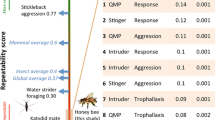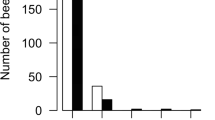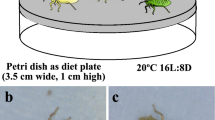Summary
The currently accepted model for division of labor in honey bees, Apis mellifera, explains variation in the frequency at which workers perform specific tasks as the result of differences in age and environment. Although well documented, the model is incomplete because it fails to take genotypic variability among workers into account. We show that workers from two genetically distinct strains of honey bees differed in the age at which they began foraging and in the relative frequency at which they foraged for pollen. Workers from the two strains also exhibited significant spatial heterogeneity within the nest, suggesting that they differed in the frequency at which they performed within-nest tasks as well. A heuristic model of division of labor that incorporates genotypic effects is presented.
Similar content being viewed by others
References
Collins AM, Rinderer TE, Harbo JR, Bolten AB (1982) Colony defense by Africanized and European honey bees. Science 218:72–74
Free JB (1965) The allocation of duties among worker honey-bees. Symp Zool Soc Lond 14:39–59
Gary NE, Lorenzen K (1976) How to construct and maintain an observation bee hive. University of California, Division of Agricultural Sciences, Cooperative Extension Leaflet 2853
Hellmich RL II (1983) Genetic and behavioral analysis of pollen hoarding in the honey bee Apis mellifera. PhD Dissertation, The Ohio State University
Hellmich RL II, Kulincevic JM, Rothenbuhler WC (1985) Selection for high and low pollen-hoarding honey bees. J Hered 76:155–158
Hellmich RL II, Danka RG, Collins AM, Rinderer TE (1986) Laying-worker production of drones in mixed colonies of Africanized and European honey bees (Hymenoptera: Apidae). Ann Entomol Soc Am 79:833–836
Kolmes SA (1986) Age polyethism in worker honey bees. Ethology 71:252–255
Laidlaw HH (1974) Relationships of bees within a colony. Apiacta 9:49–52
Lindauer M (1953a) Division of labor in the honeybee colony. Bee Wld 34:63–73
Lindauer M (1953b) Division of labor in the honeybee colony. Bee Wld 34:85–90
Momot JP, Rothenbuhler WC (1971) Behavior genetics of nest cleaning in honeybees. VI. Interactions of age and genotype of bees, and nectar flow. J Apic Res 10:11–21
Moritz RFA, Hillesheim E (1985) Inheritance of dominance in honeybees (Apis mellifera capensis Esch.). Behav Ecol Sociobiol 17:87–89
Oster GF, Wilson EO (1978) Caste and ecology in the social insects. Princeton University Press, Princeton, NJ
Owen RE (1986) Colony-level selection in the social insects: single locus additive and nonadditive models. Theor Pop Biol 29:198–234
Page RE (1986) Sperm utilization in social insects. Annu Rev Entomol 31:297–320
Parker RL (1926) The collection and utilization of pollen by the honeybee. Cornell University Agricultural Experiment Station Memoir 98
Pianka ER (1974) Evolutionary ecology. Harper and Row, New York, NY, pp 123–125
Ribbands CR (1952) Division of labour in the honeybee community. Proc R Soc B 140:32–43
Robinson GE (1985) Effects of a juvenile hormone analogue on honey bee foraging behavior and alarm pheromone production. J Insect Physiol 31:277–282
Rösch GA (1925) Untersuchungen über die Arbeitsteilung im Bienenstaat, I. Z Vergl Physiol 2:571–631
Rösch GA (1927) Uber die Bautätigkeit im Bienenvolk und das Alter der Baubienen. Z Vergl Physiol 6:264–298
Rösch GA (1930) Untersuchungen über die Arbeitsteilung im Bienenstaat. Z Vergl Physiol 12:1–71
Rothenbuhler WC (1964) Behavior genetics of nest cleaning in honey bees. IV. Responses of F1 and backcross generations to disease-killed brood. Am Zool 4:111–123
Rothenbuhler WC, Thompson VC, McDermott JJ (1968) Control of the environment of honeybee observation colonies by the use of hive-shelters and flight-cages. J Apic Res 7:151–155
Seeley TD (1982) Adaptive significance of the age polyethism schedule in honeybee colonies. Behav Ecol Sociobiol 11:287–293
Seeley TD (1985) Honeybee ecology. Princeton University Press, Princeton, NJ
Sekiguchi K, Sakagami SF (1966) Structure of foraging population and related problems in the honeybee, with considerations on the division of labor in bee colonies. Hokkaido Natn Agric Exp Stn Rep 69:1–63
Sokal RR, Rohlf FJ (1981) Biometry. Freeman, New York, NY
Winston ML, Katz SJ (1982) Foraging differences between cross-fostered honeybee workers (Apis mellifera) of European and Africanized races. Behav Ecol Sociobiol 10:125–129
Author information
Authors and Affiliations
Rights and permissions
About this article
Cite this article
Calderone, N.W., Page, R.E. Genotypic variability in age polyethism and task specialization in the honey bee, Apis mellifera (Hymenoptera: Apidae). Behav Ecol Sociobiol 22, 17–25 (1988). https://doi.org/10.1007/BF00395694
Received:
Accepted:
Issue Date:
DOI: https://doi.org/10.1007/BF00395694




